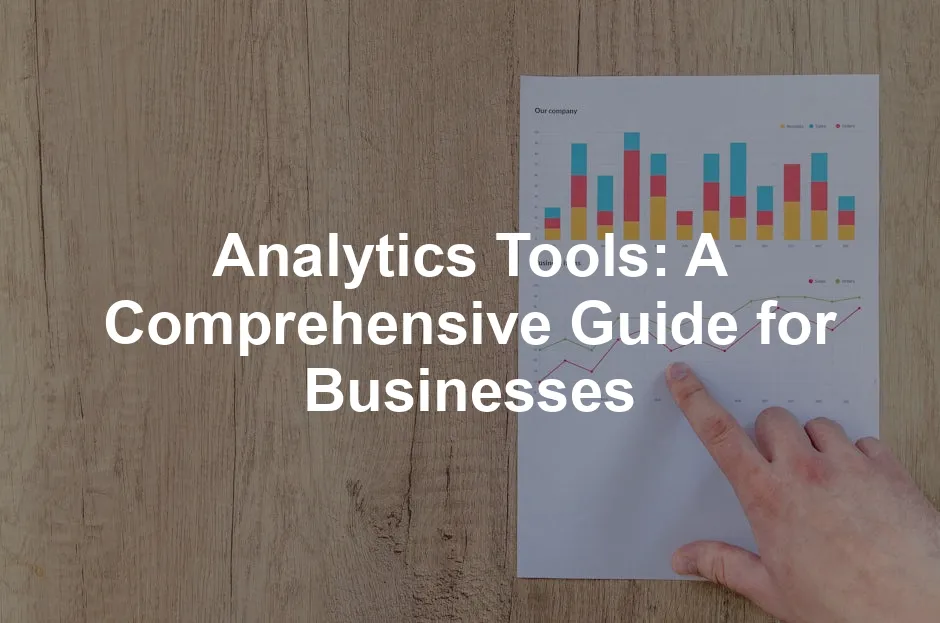Introduction
Analytics tools are essential for today’s businesses. They provide valuable insights for decision-making. As organizations increasingly rely on data, these tools help shape effective strategies. With many options available, it’s crucial to find the right tools for specific needs.
Summary and Overview
Analytics tools are software applications that analyze data to generate insights. They play a vital role in data analysis by transforming raw data into meaningful information. Choosing the right tool is critical for meeting business goals. The various types of analytics tools cater to different needs, including data visualization, predictive analytics, and business intelligence. As technology evolves, these tools are becoming more integrated with existing systems, enhancing their capabilities and effectiveness.
Understanding Analytics Tools
What Are Analytics Tools?
Analytics tools are designed to manage and analyze data effectively. Their primary purpose is to facilitate data management and decision-making. Key functionalities include data collection, visualization, and reporting. These tools drive business insights by uncovering trends and patterns within data, ultimately aiding strategic decisions.
Types of Analytics Tools
Analytics tools can be categorized into several types, each serving a unique purpose. Understanding these categories helps you choose the right tool for your needs.
Descriptive Analytics provides insights into past performance. It answers questions like, “What happened?” This type of analytics is crucial for identifying trends and patterns from historical data.
Diagnostic Analytics goes a step further by investigating reasons behind past outcomes. It helps to explain why things occurred, often using techniques like data mining or regression analysis.
Predictive Analytics focuses on forecasting future trends. By analyzing historical data, this tool predicts what is likely to happen next. Businesses can use it to anticipate customer behavior or market shifts. For instance, predictive analytics has been applied to assess the performance of the Croatia men’s national basketball team in 2024.

Predictive analytics tools can help businesses forecast future trends and behaviors. predictive analytics for croatia mens national basketball team performance 2024
Prescriptive Analytics offers actionable recommendations based on data. It suggests what steps to take next, helping businesses make informed decisions.
Web Analytics specifically analyzes website performance and user behavior. It tracks metrics like traffic sources, page visits, and user interactions, providing insights that enhance online strategies.
Each type of analytics tool serves a distinct purpose, making it essential to select the right one based on your specific business goals.

Factors to Consider When Choosing Analytics Tools
Business Needs Assessment
Before selecting analytics tools, assess your specific data analysis needs. Identify the objectives you want to achieve. Consider the scale of your data. This will help you determine the features necessary for effective analysis. For more information on effective data analysis, check out these tips for effective data analysis in economics and statistics.
Understanding your business needs is crucial for selecting the right analytics tools. tips for effective data analysis in economics and statistics
User Experience and Accessibility
User-friendly interfaces are vital for both technical and non-technical users. A tool that’s easy to navigate encourages team adoption. Consider training needs to ensure everyone feels comfortable using the tool.
Speaking of user-friendliness, if you’re looking to streamline your analytics workflow, consider using Jupyter Notebook. It allows you to create and share documents that contain live code, equations, visualizations, and narrative text. Perfect for your data analysis needs!

Integration Capabilities
When choosing analytics tools, integration with existing systems is crucial. You want tools that seamlessly connect with your current data sources. This ensures smooth data flow and helps you maximize insights. Common integrations include Customer Relationship Management (CRM) systems and data warehouses. For instance, integrating with Salesforce enhances your marketing analytics. Additionally, linking to data warehouses like Amazon Redshift allows for comprehensive data analysis. The right integrations streamline your analytics process, making it easier to extract valuable insights and improve decision-making.

Pricing Models and Budget
Analytics tools come with various pricing structures. You might encounter subscription-based models or one-time payments. Subscription models often offer flexibility, allowing you to scale as needed. On the other hand, a one-time payment may seem cost-effective but could lack ongoing support. Assessing the return on investment (ROI) is vital when considering these tools. Calculate how much value the analytics tool brings to your business. A well-chosen tool can lead to improved efficiency, better decision-making, and ultimately, higher profits. Always weigh the costs against the potential benefits.

Popular Analytics Tools Overview
Leading Analytics Tools in the Market
Microsoft Power BI
Microsoft Power BI is a powerful analytics tool that excels in data visualization. It connects with various data sources, making it versatile for businesses of all sizes. Its user-friendly interface allows users to create interactive reports easily. Power BI’s real-time dashboards provide instant insights, helping teams make informed decisions quickly. It’s perfect for organizations looking to enhance their data-driven strategies. Businesses can leverage Power BI to transform raw data into actionable insights, promoting a data-centric culture. For those interested, you can explore Microsoft Power BI Desktop to boost your analytics capabilities!
Tableau
Tableau is renowned for its robust data visualization capabilities. It allows users to create stunning, interactive dashboards that are easy to share. With an intuitive drag-and-drop interface, even non-technical users can create meaningful visualizations. Tableau integrates with numerous data sources, providing a comprehensive view of your analytics. Its advanced analytics features, like predictive modeling, give businesses a competitive edge. Organizations rely on Tableau to uncover trends and drive strategic decision-making effectively. If you want to take your visualizations to the next level, consider Tableau Software.

Other Notable Tools
There are several other noteworthy analytics tools worth considering. Qlik offers a self-service data analytics platform that caters to both technical and non-technical users, ideal for real-time data insights. SAS specializes in advanced analytics, providing solutions that integrate machine learning and data management for large enterprises. Looker focuses on data exploration and business intelligence, allowing users to create customized reports effortlessly. Tableau excels in visual analytics, enabling users to build interactive dashboards from diverse data sources. IBM Cognos provides AI-driven insights for businesses looking to enhance decision-making processes. Each of these tools serves unique purposes, enhancing data-driven strategies for various industries. For example, you can learn more about SAS and its applications in analyzing Arkansas crime statistics.

SAS is a notable tool for advanced analytics, especially in crime statistics analysis. arkansas crime statistics
Additionally, if you’re diving deep into data science, consider picking up Data Science for Dummies. This book is a great introduction to the field, making complex concepts accessible!

Conclusion
In this article, we covered the essentials of analytics tools. We explored their critical role in data analysis and decision-making. Selecting the right analytics tool can significantly impact your business success. These tools help uncover insights, track performance, and enhance strategies.
Don’t hesitate to experiment with different options. Each tool has unique features that might suit your specific needs. Take the time to explore various analytics tools. Finding the perfect fit can elevate your business to new heights. And while you’re at it, don’t forget to check out The Data Warehouse Toolkit: The Definitive Guide to Dimensional Modeling for more in-depth knowledge!

FAQs
What are analytics tools used for?
Analytics tools are software applications that help businesses analyze data. They transform raw data into meaningful insights. This process supports decision-making and strategic planning. By using these tools, organizations can track performance and identify trends.
How do I choose the right analytics tool for my business?
When selecting an analytics tool, consider several factors. First, assess your specific data needs and objectives. Evaluate the user experience and ensure it’s accessible. Integration capabilities with existing systems are crucial. Finally, consider your budget and the potential return on investment.
Are there free analytics tools available?
Yes, several free or low-cost analytics tools exist. Google Analytics is a popular option for web analytics. Other notable tools include Microsoft Power BI, which offers a free tier, and Tableau Public for data visualization.
How can analytics tools improve my business?
Analytics tools can significantly enhance business performance. They provide insights that inform strategic decisions. By leveraging data effectively, companies can optimize operations and improve customer experiences. This leads to increased efficiency and potential revenue growth.
What are the key features to look for in an analytics tool?
When evaluating analytics tools, focus on essential features. Look for user-friendly interfaces that simplify navigation. Real-time data processing is vital for timely insights. Customizable reporting options can enhance usability. Additionally, ensure the tool supports integration with various data sources for comprehensive analysis.
Please let us know what you think about our content by leaving a comment down below!
Thank you for reading till here 🙂
All images from Pexels




